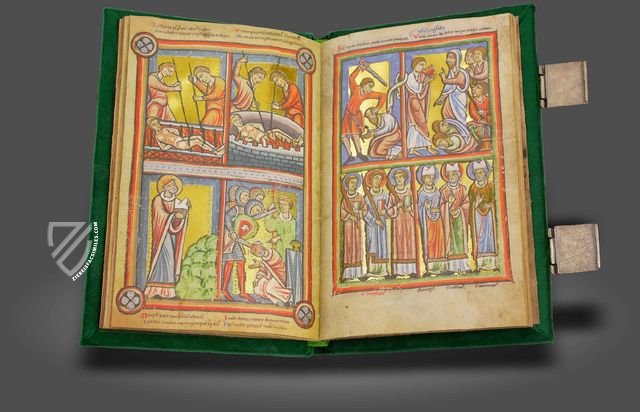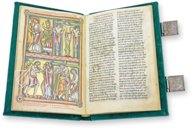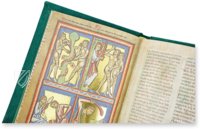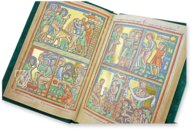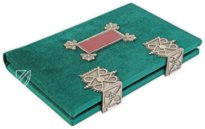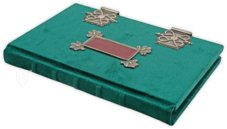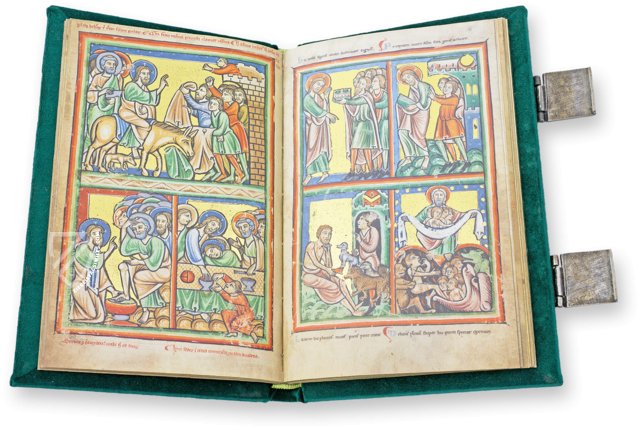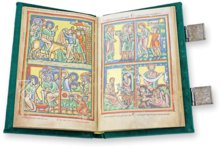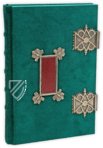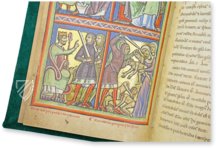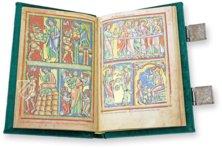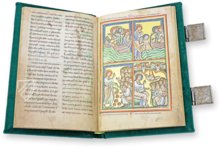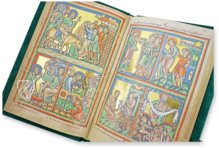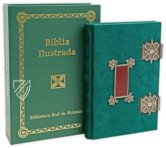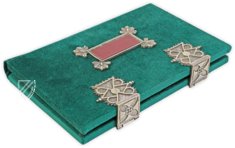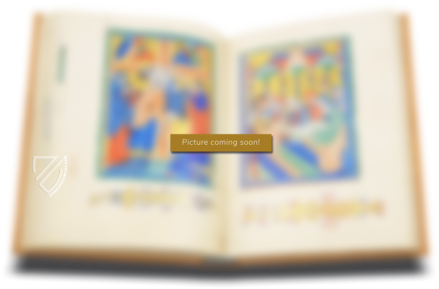Illustrated Bible of The Hague
(3,000€ - 7,000€)
This magnificent 12th century manuscript originates from the Benedictine Abbey of St. Bertin in the northwest of France but is strongly influenced by the Byzantine artistic tradition. Due to the presence of some texts that are critical of the Second Crusade and the Roman Papacy, it is believed that the manuscript was originally commissioned by Byzantine Emperor Manuel I Komnenos. It is adorned with 45 full-page miniatures and 172 illustrations altogether with scenes from the Old and New Testaments as well as a collection of saints’ vitae. They are remarkable for their extremely vivid color scheme, splendid gold figures, and flat representations in colorful decorative frames. The highly coveted manuscript passed through the hands of various bibliophiles before finally being acquired by King William I of the Netherlands.
Illustrated Bible of The Hague
The so-called Illustrated Bible of The Hague is a 12th century French manuscript that has been illustrated from end-to-end. It originated in the Benedictine Abbey of St. Bertin in the northwest of France, but exhibits clear Byzantine influences nonetheless. Presumably, even the name of the Byzantine Emperor Manuel I Komnenos is connected to the manuscript, as can be guessed from a reproachful text against Rome concerning the Second Crusade on two pages in the book. 172 images in total illustrate the Old and New Testament in marvelous, precious miniatures. A manuscript with a truly exciting story!
The Bible Illustrations
A total 45 full-page miniatures illustrate the 94 pages of the so-called Illustrated Bible of The Hague, each of which is divided into four image fields. As a result, there is a comprehensive pictorial décor of 172 illustrations altogether with scenes from the Old and New Testaments. They present the cycle of Salvation, beginning with the tale of Adam and Eve and ending with the Last Judgement. Additionally, a few tales of the lives and martyrdoms of saints are pictorially represented.
France and Byzantium
The precious manuscript with text in Latin and French originated at the end of the 12th century, it was finally appended with an additional text a century later. The illustrated Bible originates from the Benedictine Abbey of St. Bertin in the northwest of France. Nonetheless, the treatment of the miniatures, some of them presented against gold backgrounds, clearly indicates Byzantine influences. An extremely vivid color scheme, splendid gold figures, and flat representations distinguish the paintings in colorful decorative frames.
The Byzantine Emperor and the Dutch King
An additional indication of a Byzantine connection is hidden in the manuscript: aside from the clear Byzantine influences in the miniatures, one can find an indictment against the Second Crusade and against Rome on both the first and last pages of the manuscript. This has led to the assumption that the manuscript was originally a commission of the Byzantine Emperor Manuel I Komnenos (1118–1180). Additionally, the marvelous illustrations of the Bible probably served originally as the preface of a Psalter. In the 18th century, the manuscript of the Illustrated Bible of The Hague found itself in the possession of Joseph Désiré Lupus before it was acquired by King William I of the Netherlands. It finally reached the Koninklijke Bibliotheek von den Haag in 1823.
Codicology
- Alternative Titles
- Biblia Ilustrada de La Haya
Illustrierte Bibel von Den Haag - Size / Format
- 94 pages / 25.5 × 16.5 cm
- Origin
- France
- Date
- 1190–1200; Added text: 1290–1300
- Style
- Genre
- Script
- Protogothic minuscule Gothic Textura
- Illustrations
- 172 colored images in 45 full-page miniatures
- Content
- Map of Jerusalem, picture cycle with Latin tituli, computistical table, Latin prayers, the Office of the Trinity, moralizing treatise "Autorités", "Complainte de Jérusalem" by Huon de Saint-Quentin
- Previous Owners
- Joseph Désiré Lupus
King William I of The Netherlands (1772–1843)
Illustrated Bible of The Hague
Moses Parting the Red Sea
The Pharaoh, his soldiers, and all their chariots are shown being swept away by the waters of the Red Sea as Moses leads the Israelites to safety. This miracle and demonstration of God’s power galvanized the faith of the Israelites as they prepare for their 40-year-ordeal in the desert. On the left, the Israelites proceed with understandably concerned faces as Moses keeps his arm and staff raised, their divine protection symbolized by a diamond-patterned gold leaf background.
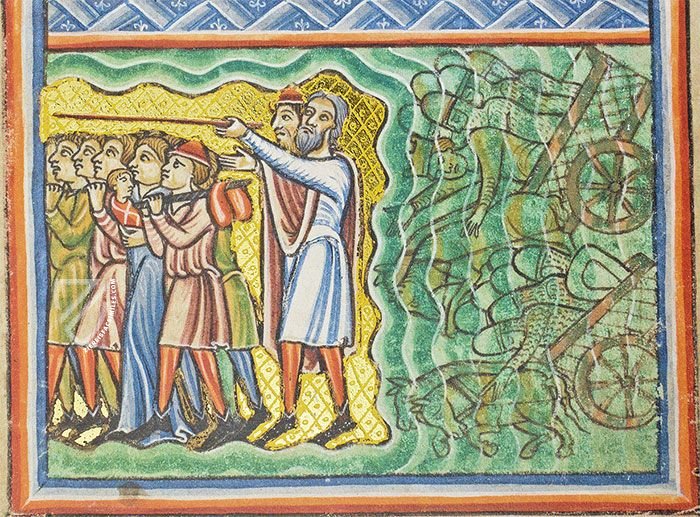
Illustrated Bible of The Hague
Map of Jerusalem
Surrounded by other important biblical sites like Bethlehem, Bethany, and Jericho, this is a schematic map of the city of Jerusalem resembling a mappa mundi. Prominent landmarks in the city are depicted including its main gates, the Temple of Solomon, and Golgotha. It is composed of bright primary colors and is generously embellished with glimmering gold leaf.
The bas-de-page miniature reminds us that this manuscript was created in the 12th century during the height of the Crusades: it shows a Crusader knight dressed in white pursuing a wounded enemy on horseback. The burnished gold background of this and other miniatures points to the influence of Byzantine art in France and the rest of the West during this period.

#1 Biblia Ilustrada de La Haya
Language: Spanish
(3,000€ - 7,000€)
- Treatises / Secular Books
- Apocalypses / Beatus
- Astronomy / Astrology
- Bestiaries
- Bibles / Gospels
- Chronicles / History / Law
- Geography / Maps
- Saints' Lives
- Islam / Oriental
- Judaism / Hebrew
- Single Leaf Collections
- Leonardo da Vinci
- Literature / Poetry
- Liturgical Manuscripts
- Medicine / Botany / Alchemy
- Music
- Mythology / Prophecies
- Psalters
- Other Religious Books
- Games / Hunting
- Private Devotion Books
- Other Genres
- Afghanistan
- Armenia
- Austria
- Belgium
- Belize
- Bosnia and Herzegovina
- China
- Colombia
- Costa Rica
- Croatia
- Cyprus
- Czech Republic
- Denmark
- Egypt
- El Salvador
- Ethiopia
- France
- Germany
- Greece
- Guatemala
- Honduras
- Hungary
- India
- Iran
- Iraq
- Israel
- Italy
- Japan
- Jordan
- Kazakhstan
- Kyrgyzstan
- Lebanon
- Liechtenstein
- Luxembourg
- Mexico
- Morocco
- Netherlands
- Palestine
- Panama
- Peru
- Poland
- Portugal
- Romania
- Russia
- Serbia
- Spain
- Sri Lanka
- Sweden
- Switzerland
- Syria
- Tajikistan
- Turkey
- Turkmenistan
- Ukraine
- United Kingdom
- United States
- Uzbekistan
- Vatican City
- A. Oosthoek, van Holkema & Warendorf
- Aboca Museum
- Ajuntament de Valencia
- Akademie Verlag
- Akademische Druck- u. Verlagsanstalt (ADEVA)
- Aldo Ausilio Editore - Bottega d’Erasmo
- Alecto Historical Editions
- Alkuin Verlag
- Almqvist & Wiksell
- Amilcare Pizzi
- Andreas & Andreas Verlagsbuchhandlung
- Archa 90
- Archiv Verlag
- Archivi Edizioni
- Arnold Verlag
- ARS
- Ars Magna
- ArtCodex
- AyN Ediciones
- Azimuth Editions
- Badenia Verlag
- Bärenreiter-Verlag
- Belser Verlag
- Belser Verlag / WK Wertkontor
- Benziger Verlag
- Bernardinum Wydawnictwo
- BiblioGemma
- Biblioteca Apostolica Vaticana (Vaticanstadt, Vaticanstadt)
- Bibliotheca Palatina Faksimile Verlag
- Bibliotheca Rara
- Boydell & Brewer
- Bramante Edizioni
- Bredius Genootschap
- Brepols Publishers
- British Library
- C. Weckesser
- Caixa Catalunya
- Canesi
- CAPSA, Ars Scriptoria
- Caratzas Brothers, Publishers
- Carus Verlag
- Casamassima Libri
- Centrum Cartographie Verlag GmbH
- Chavane Verlag
- Christian Brandstätter Verlag
- Circulo Cientifico
- Club Bibliófilo Versol
- Club du Livre
- CM Editores
- Collegium Graphicum
- Collezione Apocrifa Da Vinci
- Comissão Nacional para as Comemorações dos Descobrimentos Portugueses
- Coron Verlag
- Corvina
- CTHS
- D. S. Brewer
- Damon
- De Agostini/UTET
- De Nederlandsche Boekhandel
- De Schutter
- Deuschle & Stemmle
- Deutscher Verlag für Kunstwissenschaft
- DIAMM
- Droz
- E. Schreiber Graphische Kunstanstalten
- Ediciones Boreal
- Ediciones Grial
- Ediclube
- Edições Inapa
- Edilan
- Editalia
- Edition Deuschle
- Edition Georg Popp
- Edition Leipzig
- Edition Libri Illustri
- Editiones Reales Sitios S. L.
- Éditions de l'Oiseau Lyre
- Editions Medicina Rara
- Editorial Casariego
- Editorial Mintzoa
- Editrice Antenore
- Editrice Velar
- Edizioni Edison
- Egeria, S.L.
- Eikon Editores
- Electa
- Emery Walker Limited
- Enciclopèdia Catalana
- Eos-Verlag
- Ephesus Publishing
- Ernst Battenberg
- Eugrammia Press
- Extraordinary Editions
- Fackelverlag
- Facsimila Art & Edition
- Facsimile Editions Ltd.
- Facsimilia Art & Edition Ebert KG
- Faksimile Verlag
- Feuermann Verlag
- Folger Shakespeare Library
- Franco Cosimo Panini Editore
- Friedrich Wittig Verlag
- Fundación Hullera Vasco-Leonesa
- G. Braziller
- Gabriele Mazzotta Editore
- Gebr. Mann Verlag
- Gesellschaft für graphische Industrie
- Getty Research Institute
- Giovanni Domenico de Rossi
- Giunti Editore
- Graffiti
- Grafica European Center of Fine Arts
- Guido Pressler
- Guillermo Blazquez
- Gustav Kiepenheuer
- H. N. Abrams
- Harrassowitz
- Harvard University Press
- Helikon
- Hendrickson Publishers
- Henning Oppermann
- Herder Verlag
- Hes & De Graaf Publishers
- Hoepli
- Holbein-Verlag
- Houghton Library
- Hugo Schmidt Verlag
- Idion Verlag
- Il Bulino, edizioni d'arte
- ILte
- Imago
- Insel Verlag
- Insel-Verlag Anton Kippenberger
- Instituto de Estudios Altoaragoneses
- Instituto Nacional de Antropología e Historia
- Istituto dell'Enciclopedia Italiana - Treccani
- Istituto Ellenico di Studi Bizantini e Postbizantini
- Istituto Geografico De Agostini
- Istituto Poligrafico e Zecca dello Stato
- Italarte Art Establishments
- Jan Thorbecke Verlag
- Johnson Reprint Corporation
- Josef Stocker
- Josef Stocker-Schmid
- Jugoslavija
- Karl W. Hiersemann
- Kasper Straube
- Kaydeda Ediciones
- Kindler Verlag / Coron Verlag
- Kodansha International Ltd.
- Konrad Kölbl Verlag
- Kurt Wolff Verlag
- La Liberia dello Stato
- La Linea Editrice
- La Meta Editore
- Lambert Schneider
- Landeskreditbank Baden-Württemberg
- Leo S. Olschki
- Les Incunables
- Liber Artis
- Library of Congress
- Libreria Musicale Italiana
- Lichtdruck
- Lito Immagine Editore
- Lumen Artis
- Lund Humphries
- M. Moleiro Editor
- Maison des Sciences de l'homme et de la société de Poitiers
- Manuscriptum
- Martinus Nijhoff
- Maruzen-Yushodo Co. Ltd.
- MASA
- Massada Publishers
- McGraw-Hill
- Metropolitan Museum of Art
- Militos
- Millennium Liber
- Müller & Schindler
- Nahar - Stavit
- Nahar and Steimatzky
- National Library of Wales
- Neri Pozza
- Nova Charta
- Oceanum Verlag
- Odeon
- Orbis Mediaevalis
- Orbis Pictus
- Österreichische Staatsdruckerei
- Oxford University Press
- Pageant Books
- Parzellers Buchverlag
- Patrimonio Ediciones
- Pattloch Verlag
- PIAF
- Pieper Verlag
- Plon-Nourrit et cie
- Poligrafiche Bolis
- Presses Universitaires de Strasbourg
- Prestel Verlag
- Princeton University Press
- Prisma Verlag
- Priuli & Verlucca, editori
- Pro Sport Verlag
- Propyläen Verlag
- Pytheas Books
- Quaternio Verlag Luzern
- Reales Sitios
- Recht-Verlag
- Reichert Verlag
- Reichsdruckerei
- Reprint Verlag
- Riehn & Reusch
- Roberto Vattori Editore
- Rosenkilde and Bagger
- Roxburghe Club
- Salerno Editrice
- Saltellus Press
- Sandoz
- Sarajevo Svjetlost
- Schöck ArtPrint Kft.
- Schulsinger Brothers
- Scolar Press
- Scrinium
- Scripta Maneant
- Scriptorium
- Shazar
- Siloé, arte y bibliofilia
- SISMEL - Edizioni del Galluzzo
- Sociedad Mexicana de Antropología
- Société des Bibliophiles & Iconophiles de Belgique
- Soncin Publishing
- Sorli Ediciones
- Stainer and Bell
- Studer
- Styria Verlag
- Sumptibus Pragopress
- Szegedi Tudomànyegyetem
- Taberna Libraria
- Tarshish Books
- Taschen
- Tempus Libri
- Testimonio Compañía Editorial
- Thames and Hudson
- The Clear Vue Publishing Partnership Limited
- The Facsimile Codex
- The Folio Society
- The Marquess of Normanby
- The Richard III and Yorkist History Trust
- Tip.Le.Co
- TouchArt
- TREC Publishing House
- TRI Publishing Co.
- Trident Editore
- Tuliba Collection
- Typis Regiae Officinae Polygraphicae
- Union Verlag Berlin
- Universidad de Granada
- University of California Press
- University of Chicago Press
- Urs Graf
- Vallecchi
- Van Wijnen
- VCH, Acta Humaniora
- VDI Verlag
- VEB Deutscher Verlag für Musik
- Verlag Anton Pustet / Andreas Verlag
- Verlag Bibliophile Drucke Josef Stocker
- Verlag der Münchner Drucke
- Verlag für Regionalgeschichte
- Verlag Styria
- Vicent Garcia Editores
- W. Turnowski Ltd.
- W. Turnowsky
- Waanders Printers
- Wiener Mechitharisten-Congregation (Wien, Österreich)
- Wissenschaftliche Buchgesellschaft
- Wissenschaftliche Verlagsgesellschaft
- Wydawnictwo Dolnoslaskie
- Xuntanza Editorial
- Zakład Narodowy
- Zollikofer AG

